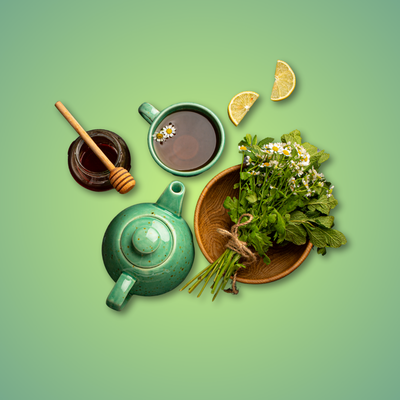In the ever-evolving landscape of women's health and well-being, the allure of natural solutions continues to grow. Among the myriad of herbal remedies, licorice root tea stands out as a potentially beneficial beverage with a history as rich and complex as its subtly sweet flavor. For centuries, cultures around the globe have recognized the therapeutic properties of the licorice plant, and modern interest is now focusing on its specific advantages for women. This exploration delves into the world of licorice root tea, uncovering its traditional uses, general health benefits, and the unique ways it may support women's vitality.
A Journey Through Time: Traditional Uses of Licorice Root for Women
The story of licorice root is deeply intertwined with the history of medicine itself. Ancient civilizations held this plant in high esteem, with Egyptians favoring it as a sweet drink for pharaohs and both Chinese and Middle Eastern cultures employing it to alleviate inflammation and soothe digestive distress [1]. Its versatility extended beyond these applications, as it became a staple in both Eastern and Western medical traditions, addressing a wide array of ailments ranging from the common cold to liver disease, valued for its soothing and expectorant qualities [2]. This widespread historical use across diverse geographical regions underscores a long-standing recognition of its therapeutic potential.
Within these broader applications, specific uses for women's health emerged in various cultural practices. Traditional Chinese Medicine (TCM) has a long history of utilizing licorice root to manage symptoms associated with menopause [1]. This indicates an early understanding within TCM of licorice root's capacity to address the hormonal shifts women experience during this life stage. Given TCM's holistic approach to health, which emphasizes the balance of vital energy (Qi) and the interconnectedness of organ systems, the consistent application of licorice root for menopausal support suggests that practitioners observed its positive effects on women navigating this significant physiological transition. Similarly, Ayurveda, the ancient Indian system of medicine, recognizes licorice root's value for promoting overall well-being and potentially supporting reproductive health [3]. In Middle Eastern traditions, while specific applications for women might not be as explicitly documented, the general use of licorice root for soothing upset stomachs and reducing inflammation could have indirectly benefited women experiencing menstrual discomfort or digestive issues linked to hormonal fluctuations [1]. The appearance of these tailored applications within established traditional medicine systems points to an early appreciation for licorice root's potential to address female-specific physiological processes.
The Sweet Side of Health: General Benefits of Licorice Root Tea
Beyond its historical significance, licorice root tea offers a range of general health benefits that make it a compelling addition to a wellness routine. Its naturally sweet flavor makes it a palatable way to potentially support various bodily functions [4].
One of the most celebrated benefits of licorice root tea is its ability to aid digestion. It serves as a comforting after-dinner beverage that can soothe the stomach and satisfy sweet cravings [4]. Studies have indicated its effectiveness in easing symptoms of digestive problems and promoting overall digestive health [4]. The tea can help alleviate indigestion, bloating, and heartburn by exerting a soothing effect on the digestive tract [5]. Furthermore, sipping licorice root tea may stimulate the production of mucin, a protective layer in the stomach that contributes to a healthy gut environment [5]. Research also suggests that licorice root may help reduce acid reflux and indigestion [6]. Preliminary studies have found that specific herbal formulations containing licorice, such as Iberogast, may help relieve symptoms of indigestion or gastroesophageal reflux disease (GERD) [2]. Notably, deglycyrrhizinated licorice (DGL), a form of licorice with the glycyrrhizin compound removed, is sometimes used to treat peptic ulcers, canker sores, and reflux without the same potential side effects associated with regular licorice [2].
For those seeking a natural way to combat inflammation, licorice root tea presents a promising option [4]. Studies have demonstrated that licorice root possesses the ability to help reduce inflammation [4]. It contains beneficial compounds, most notably glycyrrhizin, which exhibits significant anti-inflammatory properties [6]. In some research, licorice has shown strong anti-inflammatory action, even surpassing the efficacy of hydrocortisone in certain contexts, while notably not affecting the stomach lining in the same way as some conventional anti-inflammatory drugs [8]. This potent anti-inflammatory action suggests that licorice root could contribute to a wide array of health benefits that extend beyond mere digestive comfort.
Licorice root tea can also be a valuable ally in supporting the immune system and warding off common colds. Traditional Chinese Medicine has utilized licorice for its cold-fighting properties for centuries, recognizing its potent antiviral and antimicrobial actions [4]. The tea can help soothe the symptoms of a cold and potentially prevent further illness [4]. These same antiviral and antimicrobial properties can also contribute to boosting the overall function of the immune system, helping the body defend against sickness [4]. While licorice root tea is not a preventative measure for major illnesses, it can be a supportive addition to a wellness routine, particularly during cold and flu season [4]. Historically, licorice has been a go-to remedy for coughs, asthma, and sore throats [2]. Interestingly, one study indicated that gargling with a licorice solution before undergoing anesthesia could significantly reduce the incidence of postoperative sore throat [2].
Beyond these primary benefits, licorice root tea may offer additional general health perks. Some research suggests it can be beneficial for oral health due to its anti-inflammatory, anti-adhesive, and antimicrobial properties [4]. It has also demonstrated antioxidant action, helping to combat oxidative stress in the body [6]. Certain studies indicate that licorice root may play a role in regulating blood sugar levels [8] and in protecting the health of the stomach and liver [7]. Furthermore, it has been observed to promote the elimination of phlegm, making it a traditional remedy for respiratory issues [8].
Tailored for Her: Unpacking the Benefits for Women's Health
While the general health benefits of licorice root tea are noteworthy, its potential to specifically support women's health is particularly compelling. From easing menstrual discomfort to navigating the transitions of menopause and promoting hormonal balance, this herbal tea may offer targeted support for various aspects of female well-being.
For many women, the monthly experience of menstruation can be accompanied by discomfort. Licorice root for menstruation may offer relief from period pain due to its anti-inflammatory, antispasmodic, and hormone-balancing properties [11]. A 2019 study suggested that licorice root could be a more effective option than ibuprofen for treating menstrual cramps [11]. It works by reducing inflammation through the inhibition of prostaglandin production, which are hormone-like substances that cause inflammation and uterine contractions [11]. Its antispasmodic properties can also help relax the smooth muscles of the uterus, thereby alleviating the pain caused by intense contractions during menstruation [11]. Furthermore, licorice contains components with estrogen-like activity, which can help regulate hormonal fluctuations that often exacerbate period pain, particularly in women with irregular cycles or hormonal imbalances [11]. Additionally, as an adaptogen, licorice can support the adrenal glands and reduce stress, which is known to amplify menstrual cramps [11].
The transition of menopause brings about significant hormonal shifts, and licorice root tea may offer natural support during this time. Preliminary research indicates that licorice may be effective in reducing hot flashes, a common symptom of menopause [2]. One study even suggested that licorice might be more effective than hormone replacement therapy (HRT) in improving the duration of hot flashes [2]. A 2010 study found that licorice roots significantly decreased both the frequency and severity of hot flashes in menopausal women [14]. Licorice contains phytoestrogens, plant-based compounds that can mimic the effects of estrogen in the body, potentially helping to relieve symptoms associated with both menstruation and menopause [7]. A 2012 study reported that a daily intake of 330 milligrams of licorice root led to a decrease in both the frequency and severity of hot flashes in menopausal individuals [7].
Beyond these specific life stages, licorice root may play a role in promoting overall hormonal harmony in women. One of its intriguing benefits is its ability to support hormonal balance, particularly due to the presence of phytoestrogens [5]. This attribute has led to its traditional use in addressing symptoms of hormonal imbalance, such as menstrual irregularities and menopausal discomfort [5]. Furthermore, licorice root has garnered attention for its potential role in managing polycystic ovary syndrome (PCOS) [1]. Research suggests that it can help balance irregular ovarian follicles and decrease the occurrence of ovarian cysts [1]. Studies have also indicated that licorice can reduce testosterone production from the adrenal glands in women, potentially enhancing the effects of other PCOS treatments that aim to lower androgen levels [1]. Due to its anti-androgenic effects, licorice root may offer multiple benefits for women with PCOS, helping to reduce levels of androgenic hormones like testosterone, which can alleviate symptoms such as hirsutism and acne [17]. It may also improve insulin sensitivity, a key factor in managing PCOS [17].
In today's fast-paced world, stress is a common concern for many women. Licorice root contains compounds that may support the adrenal glands, which are crucial in managing stress and anxiety [5]. By modulating cortisol levels in the body, licorice root tea may help reduce stress and provide a boost to the immune system [5]. It plays a significant role in adrenal health, aiding in maintaining healthy energy levels throughout the day by influencing the levels of cortisol and cortisone [1]. As an adaptogen, licorice root may assist women in better coping with the stresses of daily life, which can have a profound impact on overall well-being and hormonal balance [5]. Its adaptogenic properties help the body adapt to stressors by regulating the stress response.
Brewing the Perfect Cup: How to Prepare Licorice Root Tea
Incorporating licorice root tea into your routine is a simple process. Whether you prefer the convenience of tea bags or the ritual of brewing loose leaf, here's a guide to preparing this potentially beneficial beverage.
For a straightforward cup of licorice root tea, you can use 1 tablespoon of licorice root tea or a tea blend containing it for every 8 to 10 ounces of water [9]. Begin by bringing fresh water to a rapid boil in a saucepan. Once boiling, remove the pan from the heat and add the licorice root tea, using a tea strainer if you are using loose leaf. Allow the tea to steep for 5 to 10 minutes [9]. After steeping, strain the tea and pour it into your favorite teacup. While licorice root is naturally sweet, you can add a touch of honey or your preferred sweetener if desired [9].
For a more traditional and potent decoction, you can add one-fourth cup of licorice root to a medium pot of boiling water and let it simmer for at least 10 minutes before straining out the root [20]. Another method involves combining 1 teaspoon of chopped licorice root with 1 cup of water in a pot, bringing it to a boil, reducing the heat to low, and allowing it to simmer for 10 minutes before straining [19].
When it comes to dosage, moderation is key with licorice root tea [4]. While it is generally safe for consumption in moderate amounts, excessive intake can potentially affect blood pressure [4]. Health authorities recommend limiting the consumption of products containing glycyrrhizic acid, including licorice root tea, to no more than 100 milligrams per day to avoid adverse effects such as low potassium levels [9]. Due to the potential for glycyrrhizin to accumulate in the body, it is advisable not to drink licorice root tea every day [6]. For personalized guidance on the appropriate dosage and frequency for your individual needs, it is always best to consult with a healthcare professional [6].
To enhance the flavor and potentially add further health benefits, you can experiment with incorporating other herbs and spices into your licorice root tea. Consider adding a few slices of fresh ginger or a cinnamon stick while brewing for a warming and aromatic twist [19].
|
Method |
Licorice Root |
Water |
Steep/Simmer Time |
Notes |
|
Simple Steep |
1 tsp - 1 tbsp |
8-10 ounces |
5-10 minutes |
Use tea strainer for loose leaf |
|
Strong Decoction |
¼ cup |
Medium pot |
10+ minutes |
Simmer on stovetop |
|
Simmering |
1 tsp chopped root |
1 cup |
10 minutes |
Can add ginger or cinnamon |
|
General Dosage |
Moderate consumption |
As needed |
- |
Limit glycyrrhizic acid to 100mg per day |
What the Experts Say: Scientific Insights and Opinions
The traditional use of licorice root tea is extensive, and modern science is beginning to shed light on its potential benefits, particularly for women's health. While experts generally agree that more high-quality research, especially in human subjects, is needed to definitively support all traditional claims, several studies offer promising insights [6].
Regarding menstrual relief, studies suggest that licorice root may indeed be a helpful option for easing period pain due to its anti-inflammatory properties, with some research indicating its effectiveness could be comparable to that of ibuprofen [7]. Dr. Jain, for instance, highlights its anti-inflammatory, antispasmodic, and hormone-balancing properties as key mechanisms for alleviating menstrual cramps [11].
For women navigating menopause, preliminary research and several studies point to the potential of licorice root to effectively reduce the frequency and severity of hot flashes [2]. A 2010 clinical trial demonstrated a significant decrease in these symptoms among women in the licorice group [14]. Medical Herbalist Melinda McDougall also utilizes licorice in small doses to help relieve stress and balance hormones during menopause [18].
Experts have also explored licorice root as a potential supportive therapy for PCOS, primarily due to its anti-androgenic effects. Preliminary studies, largely conducted in animal models, have shown promise in its ability to influence testosterone secretion and reduce the number of ovarian cysts [15]. However, more research involving human participants is necessary to fully understand its benefits for women with PCOS.
It is crucial to note that experts also issue warnings regarding the potential side effects associated with excessive consumption of glycyrrhizin, a key compound in licorice root. These side effects can include high blood pressure and low potassium levels [2]. Therefore, they consistently advise moderation and emphasize the importance of consulting with healthcare professionals before incorporating licorice root tea into one's routine, especially for individuals with pre-existing health conditions or those taking medications [2]. The Food and Drug Administration (FDA) has not approved licorice root tea for the treatment of any specific illnesses [9].
A Word of Caution: Potential Side Effects and Contraindications
While licorice root tea offers potential health benefits, it is essential to be aware of its potential side effects and contraindications. The primary concern revolves around glycyrrhizin, a key active compound that, when consumed in excess, can lead to an accumulation in the body and trigger adverse reactions [6].
Research suggests that chronic use or high doses of licorice root products may, in rare cases, cause high blood pressure, low potassium levels, arrhythmia, kidney failure, congestive heart failure, and pulmonary edema [2]. Even moderate consumption can elevate blood pressure in individuals who are susceptible [2].
Certain groups should exercise caution or avoid licorice root tea altogether. Pregnant women are advised to avoid it due to potential risks to fetal development, including an increased risk of premature birth and potential cognitive or psychiatric issues in children [2]. The safety of licorice root tea for breastfeeding women is also uncertain [2]. Individuals with pre-existing conditions such as hypertension, heart disease, kidney disease, liver disease, low potassium (hypokalemia), diabetes, hormone-sensitive cancers (including breast, ovarian, uterine, and prostate), and fluid retention should refrain from using licorice root [2].
Furthermore, licorice root can interact with a variety of medications, including blood pressure medications (such as ACE inhibitors and diuretics), blood thinners (like warfarin), cholesterol-lowering medications, insulin or other diabetes drugs, oral contraceptives, corticosteroids, MAO inhibitors, and medications that are processed by the liver [2]. There have been reports of women taking oral contraceptives experiencing high blood pressure and low potassium levels when also consuming licorice [2].
Given these potential risks, it is crucial to consume licorice root tea in moderation and not for extended periods [2]. It is generally advised not to use any licorice product for more than 4 to 6 weeks [2]. The intake of glycyrrhizic acid should be limited to under 100mg per day [9]. Before incorporating licorice root tea into your wellness routine, especially if you have any underlying health conditions or are taking medications, it is strongly recommended that you consult with a qualified healthcare professional [2].
Beyond the Tea Cup: Herbal Remedies and Women's Well-being
The use of herbal remedies for promoting women's well-being is a practice with deep historical roots and continues to be popular today. Across various life stages, from adolescence to menopause, women often turn to natural products to support their health [26]. These remedies are frequently used to alleviate symptoms, enhance quality of life, and potentially play a role in disease prevention [27].
Historically, herbs have been employed to address a wide range of women's health concerns, including menstruation problems, vaginal infections, fertility issues, discomfort during pregnancy, and the relief of menopausal symptoms [26]. Examples of herbs traditionally used for such purposes include Angelica sinensis and Ligusticum chuanxiong for dysmenorrhea, and various others for managing menopausal symptoms like hot flashes [26].
While many women report positive experiences with herbal remedies, it is important to approach their use with a balanced perspective. The scientific evidence supporting the efficacy and safety of different herbs can vary, and it is crucial to make informed choices [7]. Some herbs may interact with conventional medications, highlighting the need for caution and consultation with healthcare professionals [28].
Ultimately, herbal remedies can be a valuable component of a holistic approach to women's well-being. This approach often integrates a nourishing diet, lifestyle modifications, and conventional medical treatments when necessary, recognizing the interconnectedness of various factors in maintaining health [16].
Choosing Quality: Tips for Sourcing Licorice Root Tea
To ensure you are getting a safe and effective product, it's important to be discerning when sourcing licorice root tea. Opt for reputable brands that have a commitment to quality and conduct thorough safety testing [28]. Look for companies that are transparent about their sourcing and production methods.
Whenever possible, choose licorice root tea that is certified organic by the USDA. This certification helps to minimize your exposure to potentially harmful pesticides, herbicides, and other chemicals that may be used in conventional farming practices [30].
Licorice root tea is available in various forms, including loose leaf, tea bags, and as part of blended herbal teas [4]. While loose leaf tea often offers a richer flavor and potentially higher quality due to less processing, tea bags provide a convenient option for busy lifestyles.
Consider the environmental impact of your choices by looking for brands that prioritize sustainable harvesting practices. Some companies may be certified by organizations like FairWild, which ensures the long-term availability of the herb and supports the livelihoods of the harvesters involved [33].
When selecting licorice root tea, pay attention to indicators of quality. The dried root should have a naturally sweet and slightly spicy aroma [29]. Avoid products that contain artificial flavors, colors, or unnecessary fillers [31].
If your primary interest in licorice root is for its digestive benefits and you have concerns about the potential side effects of glycyrrhizin, particularly if you have high blood pressure, you might consider deglycyrrhizinated licorice (DGL) tea or supplements. These products retain many of the beneficial properties of licorice root for digestion without the associated risks of glycyrrhizin [1].
Conclusion
Licorice root tea holds promise as a natural remedy that may offer a variety of health benefits for women. Its traditional uses span centuries and cultures, and modern research is beginning to validate some of these applications, particularly in areas such as menstrual comfort, menopause support, hormonal balance, and stress relief. However, it is crucial to approach licorice root tea with awareness and respect for its potency. Due to its glycyrrhizin content, moderation is essential, and individuals with certain health conditions or those taking specific medications should exercise caution and consult with their healthcare providers before making it a regular part of their wellness routine. By choosing high-quality, responsibly sourced products and using them judiciously, women can explore the potential of licorice root tea to support their health and well-being as part of a holistic and informed approach.






